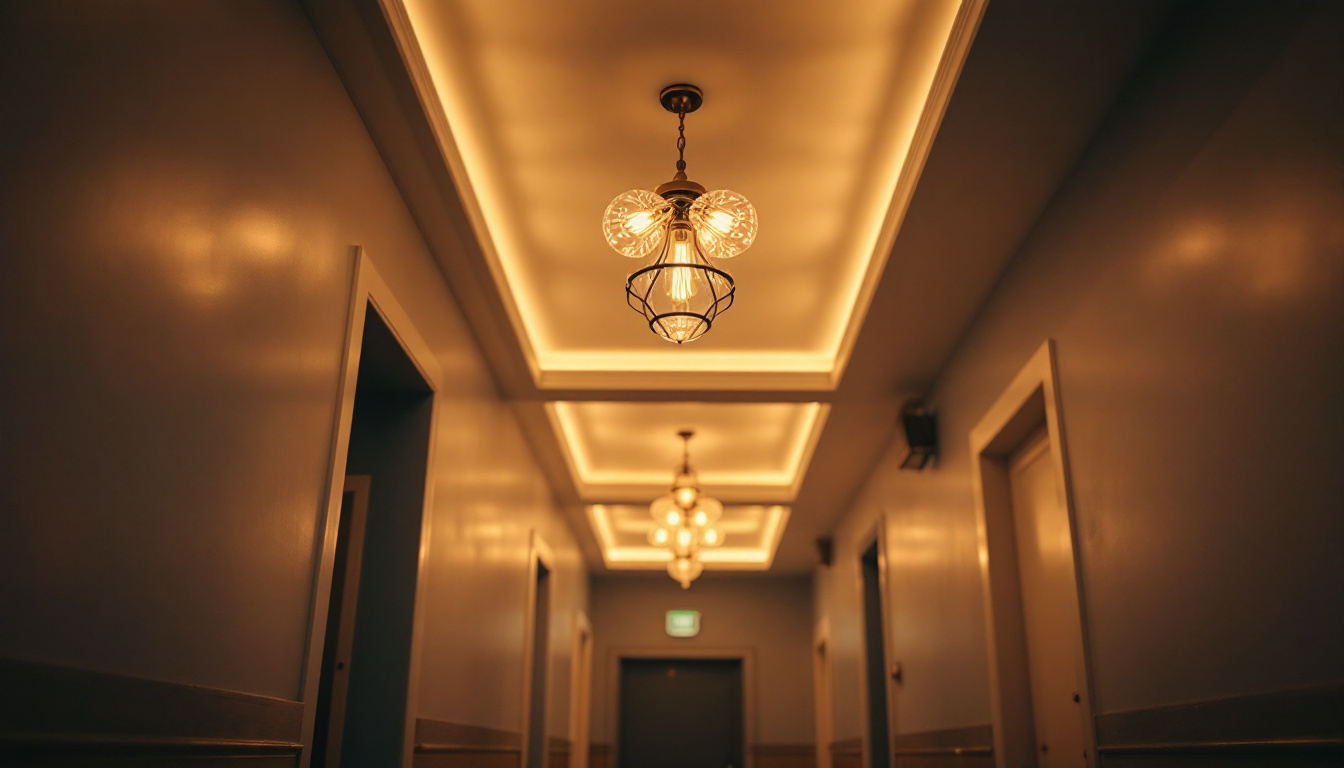
In the realm of interior design and construction, lighting plays a pivotal role in enhancing the atmosphere and functionality of a space. For lighting contractors, understanding the nuances of ceiling lamps, particularly for hallways, is essential. Hallways often serve as transitional spaces, connecting different areas of a home or building. Therefore, selecting the right ceiling lamps can significantly impact both aesthetics and safety. This article delves into the various aspects of ceiling lamps for hallways, providing valuable insights for lighting contractors.
Hallways are often overlooked when it comes to lighting design, yet they are crucial for creating a welcoming environment. The right ceiling lamps can transform a dull corridor into an inviting passage. Proper lighting not only enhances visibility but also adds character to the space. A well-lit hallway can serve as a prelude to the rooms it connects, setting the tone for what lies beyond. Whether it’s a home, office, or public building, the lighting in hallways plays a significant role in the overall experience of the space.
Moreover, well-lit hallways contribute to safety by reducing the risk of accidents. Poorly lit areas can be hazardous, especially in residential and commercial settings where foot traffic is common. Therefore, lighting contractors must prioritize effective illumination in these transitional spaces. Beyond just preventing trips and falls, good lighting can also deter crime, as well-lit areas are less appealing to potential intruders. This dual function of aesthetics and safety makes hallway lighting a vital consideration in any design project.
Ambiance is a key element in any interior space. Hallways, while functional, can also serve as a canvas for creativity. The choice of ceiling lamps can influence the mood of the corridor. For instance, warm-toned lights can create a cozy atmosphere, while cooler tones may lend a more modern feel. Additionally, the use of dimmable fixtures allows for flexibility, enabling the lighting to adapt to various occasions, from quiet family gatherings to lively social events.
Lighting contractors should consider the overall design theme of the space when selecting ceiling lamps. A contemporary hallway may benefit from sleek, minimalist fixtures, while a traditional setting might call for ornate designs. Understanding the interplay between light and design is essential for achieving the desired ambiance. Furthermore, incorporating accent lighting, such as wall sconces or LED strips along the baseboards, can highlight architectural features and artwork, adding layers of depth and interest to the hallway. This thoughtful approach to lighting not only enhances the aesthetic appeal but also invites exploration and engagement with the space.
Safety is paramount in any lighting project. Hallways are often high-traffic areas, and adequate lighting is crucial to prevent accidents. Ceiling lamps should provide sufficient illumination to ensure that individuals can navigate the space safely. In addition to brightness, the placement of ceiling lamps is also important. Strategic positioning can help eliminate shadows and dark spots, further enhancing safety. Lighting contractors should evaluate the layout of the hallway and determine the best locations for fixtures to maximize visibility.
Moreover, the integration of motion sensors can enhance safety by automatically turning on lights as individuals approach, ensuring that the hallway is always well-lit when needed. This feature is particularly beneficial in homes with children or elderly residents, as it minimizes the risk of falls during late-night trips. Additionally, using energy-efficient LED bulbs not only reduces energy costs but also ensures that the lighting remains effective over time, providing a consistent level of safety and visibility. By prioritizing both functionality and security, hallway lighting can significantly impact the overall safety and usability of a space.
When selecting ceiling lamps for hallways, there are several types to consider. Each type offers unique benefits and can be tailored to suit different design preferences and functional needs.
Flush mount ceiling lamps are a popular choice for hallways due to their low profile and versatility. These fixtures sit directly against the ceiling, making them ideal for spaces with low ceilings. They provide ample light without protruding into the walkway, ensuring that the corridor remains open and unobstructed.
Available in various styles and finishes, flush mount lamps can complement any design theme. From sleek, modern designs to more traditional options, lighting contractors have a wide array of choices to suit their clients’ preferences.
Pendant lights offer a stylish alternative to flush mount fixtures. Hanging from the ceiling, they can create a focal point in the hallway while providing functional lighting. Pendant lights are particularly effective in spaces with higher ceilings, where they can add visual interest without overwhelming the area.
When selecting pendant lights, contractors should consider the scale and height of the hallway. A cluster of smaller pendants can create a dramatic effect, while a single, larger pendant may provide a more understated look. The design should harmonize with the overall aesthetic of the space.
Recessed lighting is another excellent option for hallways. These fixtures are installed into the ceiling, providing a clean and unobtrusive look. Recessed lights can be used to create a wash of light along the walls, enhancing the perception of space and depth.
Lighting contractors should pay attention to the spacing and placement of recessed lights. Properly spaced fixtures can eliminate dark spots and ensure even illumination throughout the hallway. Additionally, dimmer switches can be incorporated to allow for adjustable lighting levels, enhancing flexibility.
The choice of bulbs is as important as the selection of fixtures. Different types of bulbs offer varying levels of brightness, color temperature, and energy efficiency. For hallways, lighting contractors should consider the following factors when selecting bulbs.
Brightness is measured in lumens, and it is essential to choose bulbs that provide adequate illumination for the hallway. A well-lit hallway typically requires between 100 to 200 lumens per square meter. Contractors should calculate the total lumens needed based on the size of the hallway and the number of fixtures being used.
It’s important to strike a balance between brightness and comfort. Overly bright lights can create glare, while insufficient lighting can lead to safety concerns. Therefore, selecting the right lumens is crucial for achieving optimal lighting conditions.
Color temperature, measured in Kelvin (K), influences the ambiance of a space. For hallways, a color temperature between 2700K and 3000K is often recommended. This range produces a warm, inviting light that enhances the overall atmosphere.
However, some contractors may opt for cooler tones (3500K to 4100K) to create a more modern and vibrant feel. The choice of color temperature should align with the design intent and the preferences of the client.
Energy efficiency is a significant consideration in today’s lighting projects. LED bulbs are an excellent choice for hallway lighting due to their long lifespan and low energy consumption. They produce less heat and are available in a variety of brightness levels and color temperatures.
Incorporating energy-efficient lighting not only reduces utility costs but also aligns with sustainable design practices. Lighting contractors should educate clients about the benefits of LED technology and encourage its use in hallway lighting projects.
Proper installation is crucial for ensuring the effectiveness and safety of ceiling lamps in hallways. Lighting contractors should be aware of several key considerations during the installation process.
Before installation, contractors must assess the existing wiring and electrical requirements for the chosen fixtures. Ensuring that the electrical system can support the new lighting is essential for safety and functionality. This may involve upgrading wiring or adding additional circuits, depending on the complexity of the project.
Additionally, contractors should follow local building codes and regulations when installing ceiling lamps. Compliance with safety standards is paramount to avoid potential hazards and liability issues.
The placement of ceiling lamps can significantly impact the overall effectiveness of the lighting. Contractors should consider factors such as the width of the hallway, the height of the ceiling, and the presence of architectural features when determining fixture locations.
In general, fixtures should be spaced evenly to ensure consistent illumination. For longer hallways, multiple fixtures may be required to avoid dark spots. Additionally, contractors should consider the use of dimmers to allow for adjustable lighting levels, enhancing flexibility for different activities.
Once the ceiling lamps are installed, ongoing maintenance is essential to ensure optimal performance and longevity. Lighting contractors should provide clients with guidance on how to care for their fixtures effectively.
Regular cleaning of ceiling lamps is crucial for maintaining their appearance and functionality. Dust and debris can accumulate on fixtures, reducing light output and affecting the overall aesthetic. Contractors should recommend appropriate cleaning methods based on the materials used in the fixtures.
For example, glass and metal fixtures may require different cleaning solutions. Additionally, contractors should advise clients to periodically check and replace bulbs as needed to ensure consistent lighting levels.
As design trends evolve, clients may wish to upgrade their hallway lighting fixtures. Lighting contractors should stay informed about the latest trends and technologies to provide clients with relevant options. Upgrading to more energy-efficient fixtures or modern designs can enhance the overall appeal of the hallway.
Contractors can also offer consultations to help clients select the best options for their specific needs and preferences. By staying engaged with clients, contractors can foster long-term relationships and encourage repeat business.
Ceiling lamps for hallways are essential tools for lighting contractors, playing a critical role in enhancing safety, functionality, and aesthetics. By understanding the various types of fixtures, choosing the right bulbs, and considering installation and maintenance, contractors can deliver exceptional lighting solutions that meet their clients’ needs.
As the demand for innovative and efficient lighting solutions continues to grow, lighting contractors must remain adaptable and informed. By prioritizing the unique requirements of hallway lighting, contractors can elevate their projects and contribute to the overall success of their clients’ spaces.
Ready to enhance your hallway lighting projects with the finest selection of ceiling lamps? Look no further than LumenWholesale, where we provide lighting contractors with spec-grade lighting products at unbeatable wholesale prices. Our commitment to quality and affordability means you can access a vast array of top-tier lighting options that meet the highest industry standards. Plus, with free shipping on bulk orders, you can stock up on premium lighting solutions without worrying about hidden fees or inflated markups. Elevate your lighting projects today by visiting Wholesale Lighting at the Best Value and discover the LumenWholesale difference—where quality, affordability, and convenience shine bright.

Discover the essentials of solar-powered arena lighting with expert insights tailored for lighting contractors.

Discover how 2-inch recessed can lights can enhance profitability in lighting installations.

Discover how outlet switches are revolutionizing the lighting industry by enhancing energy efficiency, smart home integration, and user convenience.

Discover expert tips from top lighting contractors on overcoming outdoor lights commercial challenges.